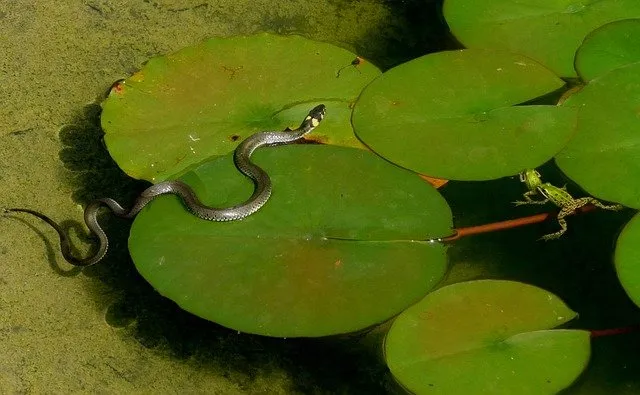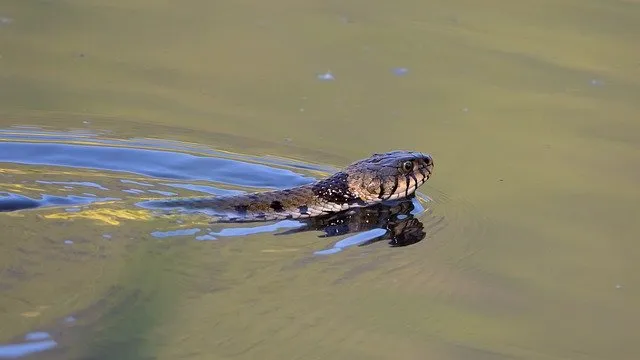As an Amazon Associate I earn from qualifying purchases.
Curious about the underwater feasts of these slithering serpents? Wonder no more, for we are about to embark on a captivating journey into the world of water snakes and their gastronomic preferences. With their sleek bodies and exceptional aquatic skills, these fascinating reptiles have carved out a unique niche in the watery realms they call home. Prepare to be amazed as we unravel the culinary delights that grace the menu of water snakes, delving into the depths of their diet to discover the surprising array of creatures that satiate their hunger. From slippery fish to crunchy crustaceans and even the occasional feathered or furry morsel, the dining habits of these serpents will leave you both astounded and captivated. So, let us plunge into the watery depths and unravel the mysteries of what exactly water snakes eat.
What Do Water Snakes Eat?
Water snakes are fascinating reptiles that have adapted to life in aquatic environments. These snakes are found in different parts of the world and have unique traits that help them survive in and around water sources. Part of understanding their ecology involves delving into their dietary preferences. In this blog post, we will dive deep into the diet of water snakes, exploring the range of foods they consume and their role in the ecosystem.
1.Fish:
One of the primary food sources for water snakes is fish. These snakes have evolved to be formidable hunters, using their sharp teeth and powerful jaws to catch and swallow fish whole. Common fish species in their diet include small minnows, sunfish, catfish, and perch. Water snakes can detect vibrations in the water, which helps them locate their prey. Once a fish is captured, the snake will use constriction or venom to immobilize it before swallowing it whole.
2.Amphibians:
Water snakes also feed on amphibians, including frogs, toads, and salamanders. These ectothermic creatures are often found near water sources, making them easily accessible to snakes. Amphibians are critical to the water snake’s diet, providing essential nutrients such as proteins and vitamins. Water snakes use ambush tactics or actively hunt these amphibians in shallow water or along the edges of ponds and streams.
3.Crustaceans:
In addition to fish and amphibians, water snakes have a penchant for crustaceans. They often consume crabs, crayfish, and other small aquatic crustaceans. These prey items provide a different nutritional profile and offer a good source of calcium, aiding in the snakes’ bone development and overall health. Water snakes employ their excellent swimming skills to hunt for crustaceans, using their agility to catch them underwater.
4.Invertebrates:
Water snakes also include a variety of invertebrates in their diet. These may include insects, small mollusks, and worms. Invertebrates serve as a supplemental food source for water snakes, allowing them to diversify their diet. Some water snake species are known to consume snails, leeches, and aquatic insect larvae. Water snakes play an important role in controlling their populations and maintaining the ecological balance in their habitats by consuming invertebrates.
5.Small Birds and Mammals:
While not as common as the prey above, some larger species of water snakes have been observed consuming small birds and mammals. This behavior is more prevalent among larger individuals or certain water snake species that inhabit areas with abundant bird or mammal populations. The snakes may ambush these prey items as they come near the water’s edge, capturing them with quick strikes and constriction.
How Do Water Snakes Hunt?
Water snakes are adept predators, utilizing various hunting strategies to secure their meals. Their hunting techniques vary depending on the species, habitat, and the specific prey they target. Here, we will delve into the fascinating world of water snake hunting, exploring the intricacies of their methods.
1.Ambush Predators:
Many water snake species are ambush predators, relying on their ability to blend seamlessly into their surroundings to surprise unsuspecting prey. They often choose strategic locations such as submerged vegetation, fallen logs, or rocky crevices, where they can wait for potential meals. These skilled hunters remain motionless, patiently observing the water for any signs of movement. When prey ventures close enough, water snakes strike with astonishing speed, seizing their target with their sharp teeth and powerful jaws. This ambush strategy is particularly effective when targeting fish, amphibians, and small crustaceans.
2.Active Foragers:
While some water snakes prefer the element of surprise, others employ an active hunting approach. These snakes utilize their excellent swimming abilities to actively search for prey. They may patrol the shallow edges of ponds, lakes, or rivers or navigate through dense underwater vegetation in pursuit of potential meals. Using their keen eyesight and sense of smell, water snakes detect the presence of prey, honing in on vibrations and disturbances in the water. Once a suitable target is identified, they swiftly launch, employing lightning-fast strikes to catch their quarry.
3.Constriction and Envenomation:
Once water snakes capture their prey, they employ different methods to immobilize and subdue it. Some species, like the Northern water snake, utilize constriction, coiling their bodies around the captured prey and exerting pressure to suffocate it. This technique is especially common when feeding larger prey, such as small mammals or birds. Other water snake species possess venomous glands, which produce toxins that incapacitate their victims. These snakes deliver a quick bite, injecting venom into the prey, leading to paralysis or death. The venom also aids in the digestion process by breaking down tissues.
4.Specialized Adaptations:
Water snakes possess several physical adaptations that aid in their hunting endeavors. Their streamlined bodies allow for swift and agile movement through the water, enabling them to quickly chase down prey. Their eyes are positioned on the top of their heads, allowing them to remain partially submerged while keeping a watchful eye above the waterline. This adaptation allows them to remain concealed while surveilling potential prey items. Additionally, water snakes have specialized sensory organs, such as Jacobson’s organs, which help them detect chemical cues in the water, aiding in locating prey.
5.Dietary Flexibility:
Water snakes are opportunistic predators, displaying a degree of dietary flexibility depending on prey availability. They can adapt their hunting techniques and adjust their diet to suit changing circumstances. This adaptability allows them to thrive in various habitats, from freshwater lakes and rivers to brackish marshes and coastal areas.
How Do Water Snakes Help Our Ecosystem?
In the intricate tapestry of ecosystems, water snakes weave their thread of ecological significance, playing a vital role in maintaining the delicate balance of nature. With their unique adaptations and hunting prowess, these serpents contribute to the health and functioning of aquatic habitats in various ways. Let’s uncover how water snakes become unsung heroes, silently working behind the scenes to help our ecosystem thrive.
Firstly, water snakes aid in controlling the populations of their prey, such as fish, amphibians, and crustaceans. By regulating these populations, they prevent unchecked growth that could lead to imbalances in the ecosystem. Additionally, water snakes act as indicators of environmental health. Their presence or absence can reflect the overall well-being of aquatic habitats, serving as bioindicators for water quality and ecosystem stability. Furthermore, when water snakes consume prey items like small mammals or birds, they help control those populations, preventing them from becoming overly abundant and potentially causing disruptions to the ecosystem.
Water snakes also contribute to nutrient cycling as they consume various organisms and later excrete waste, which enriches the water and surrounding habitat with essential nutrients. Ultimately, water snakes are an integral part of the intricate web of life, their role extending far beyond their captivating appearance. By understanding and appreciating the ecological value of water snakes, we can better comprehend the interconnectedness of all living organisms and work towards preserving and conserving these remarkable creatures and the ecosystems they call home.
Final Words
Water snakes exhibit remarkable adaptability, and their diet reflects their ability to exploit the resources in their aquatic habitats. Water snakes play a crucial role in balancing ecosystems and regulating populations by consuming fish, amphibians, crustaceans, invertebrates, and occasionally small birds and mammals. The diverse diet of these serpents showcases their ecological significance and highlights their intricate place in the natural world. Understanding the feeding habits of water snakes deepens our knowledge of these incredible creatures and enhances our appreciation for the intricacies of the ecosystems they inhabit.
You can also read
What Do Lambs Eat? Feeding Your Flock
From Roots to Berries: What Do Lemmings Eat?
Marmot Diets Decoded: What Do Marmots Eat
The Hungry House Guests: What Do Carpet Beetles Eat?
Amazon and the Amazon logo are trademarks of Amazon.com, Inc, or its affiliates.



